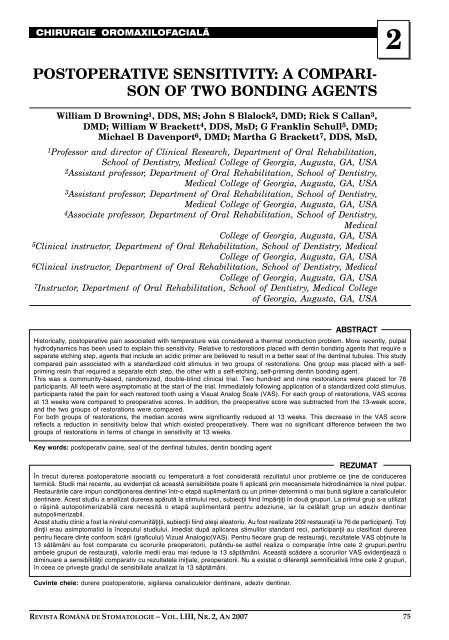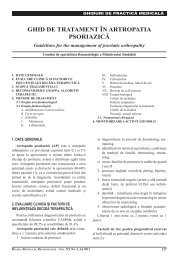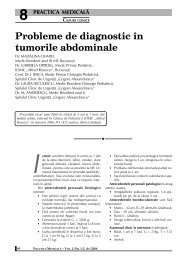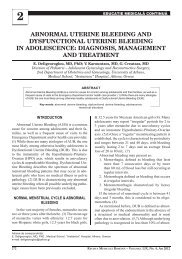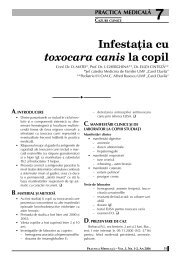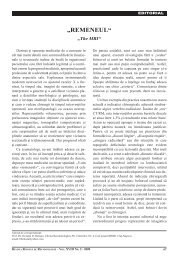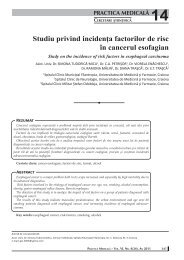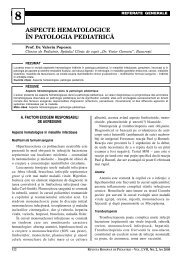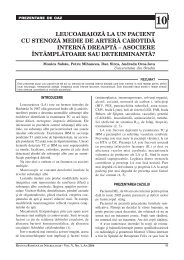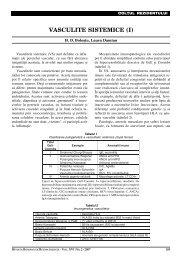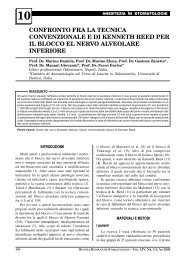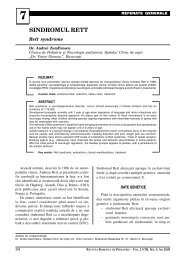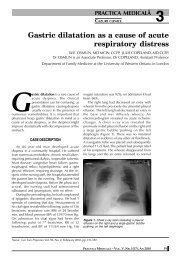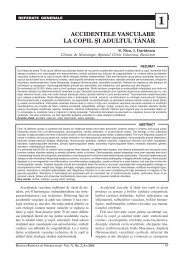Cuprins - medica.ro
Cuprins - medica.ro
Cuprins - medica.ro
Create successful ePaper yourself
Turn your PDF publications into a flip-book with our unique Google optimized e-Paper software.
CHIRURGIE OROMAXILOFACIALÅ<br />
POSTOPERATIVE SENSITIVITY: A COMPARI-<br />
SON OF TWO BONDING AGENTS<br />
William D B<strong>ro</strong>wning 1, DDS, MS; John S Blalock 2, DMD; Rick S Callan 3,<br />
DMD; William W Brackett 4 , DDS, MsD; G Franklin Schull 5 , DMD;<br />
Michael B Davenport 6, DMD; Martha G Brackett 7, DDS, MsD,<br />
1 P<strong>ro</strong>fessor and director of Clinical Research, Department of Oral Rehabilitation,<br />
School of Dentistry, Medical College of Georgia, Augusta, GA, USA<br />
2 Assistant p<strong>ro</strong>fessor, Department of Oral Rehabilitation, School of Dentistry,<br />
Medical College of Georgia, Augusta, GA, USA<br />
3 Assistant p<strong>ro</strong>fessor, Department of Oral Rehabilitation, School of Dentistry,<br />
Medical College of Georgia, Augusta, GA, USA<br />
4Associate p<strong>ro</strong>fessor, Department of Oral Rehabilitation, School of Dentistry,<br />
Medical<br />
College of Georgia, Augusta, GA, USA<br />
5 Clinical instructor, Department of Oral Rehabilitation, School of Dentistry, Medical<br />
College of Georgia, Augusta, GA, USA<br />
6Clinical instructor, Department of Oral Rehabilitation, School of Dentistry, Medical<br />
College of Georgia, Augusta, GA, USA<br />
7Instructor, Department of Oral Rehabilitation, School of Dentistry, Medical College<br />
of Georgia, Augusta, GA, USA<br />
ABSTRACT<br />
Historically, postoperative pain associated with temperature was considered a thermal conduction p<strong>ro</strong>blem. More recently, pulpal<br />
hyd<strong>ro</strong>dynamics has been used to explain this sensitivity. Relative to restorations placed with dentin bonding agents that require a<br />
separate etching step, agents that include an acidic primer are believed to result in a better seal of the dentinal tubules. This study<br />
compared pain associated with a standardized cold stimulus in two g<strong>ro</strong>ups of restorations. One g<strong>ro</strong>up was placed with a selfpriming<br />
resin that required a separate etch step, the other with a self-etching, self-priming dentin bonding agent.<br />
This was a community-based, randomized, double-blind clinical trial. Two hundred and nine restorations were placed for 76<br />
participants. All teeth were asymptomatic at the start of the trial. Immediately following application of a standardized cold stimulus,<br />
participants rated the pain for each restored tooth using a Visual Analog Scale (VAS). For each g<strong>ro</strong>up of restorations, VAS scores<br />
at 13 weeks were compared to preoperative scores. In addition, the preoperative score was subtracted f<strong>ro</strong>m the 13-week score,<br />
and the two g<strong>ro</strong>ups of restorations were compared.<br />
For both g<strong>ro</strong>ups of restorations, the median scores were significantly reduced at 13 weeks. This decrease in the VAS score<br />
reflects a reduction in sensitivity below that which existed preoperatively. There was no significant difference between the two<br />
g<strong>ro</strong>ups of restorations in terms of change in sensitivity at 13 weeks.<br />
Key words: postoperativ paine, seal of the dentinal tubules, dentin bonding agent<br />
REZUMAT<br />
În trecut durerea postoperatorie asociatå cu temperaturå a fost consideratå rezultatul unor p<strong>ro</strong>bleme ce ¡ine de conducerea<br />
termicå. Studii mai recente, au eviden¡iat cå aceastå sensibilitate poate fi aplicatå prin mecanismele hid<strong>ro</strong>dinamice la nivel pulpar.<br />
Restaurårile care impun condi¡ionarea dentinei într-o etapå suplimentarå cu un primer determinå o mai bunå sigilare a canaliculelor<br />
dentinare. Acest studiu a analizat durerea apårutå la stimului reci, subiec¡ii fiind împår¡i¡i în douå grupuri. La primul grup s-a utilizat<br />
o rå¿inå autopolimerizabilå care necesitå o etapå suplimentarå pentru adeziune, iar la celålalt grup un adeziv dentinar<br />
autopolimerizabil.<br />
Acest studiu clinic a fost la nivelul comunitå¡i¡ii, subiec¡ii fiind ale¿i aleatoriu. Au fost realizate 209 restaura¡ii la 76 de participan¡i. To¡i<br />
din¡ii erau asimptomatici la începutul studiului. Imediat dupå aplicarea stimulilor standard reci, participan¡ii au clasificat durerea<br />
pentru fiecare dinte conform scårii (graficului) Vizual Analogic(VAS). Pentru fiecare grup de restaura¡ii, rezultatele VAS ob¡inute la<br />
13 såtåmâni au fost comparate cu scorurile preoperatorii, putându-se astfel realiza o compara¡ie între cele 2 grupuri.pentru<br />
ambele grupuri de restaura¡ii, valorile medii erau mai reduse la 13 såptåmâni. Aceastå scådere a scorurilor VAS eviden¡ieazå o<br />
diminuare a sensibilitå¡ii comparativ cu rezultatele ini¡iale, preoperatorii. Nu a existat o diferen¡å semnificativå între cele 2 grupuri,<br />
în ceea ce prive¿te gradul de sensibiliate analizat la 13 såptåmâni.<br />
Cuvinte cheie: durere postoperatorie, sigilarea canaliculelor dentinare, adeziv dentinar.<br />
REVISTA ROMÂNÅ DE STOMATOLOGIE – VOL. LIII, NR. 2, AN 2007 75<br />
2


